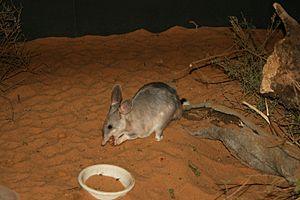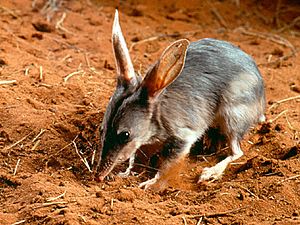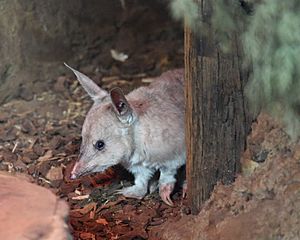Macrotis facts for kids
Quick facts for kids Macrotis |
|
|---|---|
 |
|
| A greater bilby at Monarto Safari Park | |
| Scientific classification |
|
| Kingdom: | Animalia |
| Phylum: | Chordata |
| Class: | Mammalia |
| Infraclass: | Marsupialia |
| Order: | Peramelemorphia |
| Family: | Thylacomyidae Bensley, 1903 |
| Genus: | Macrotis Reid, 1837 |
| Type species | |
| Perameles lagotis Reid, 1837
|
|
| Species | |
| Synonyms | |
|
Paragalia Gray, 1841 |
|
Macrotis is a group of amazing desert animals called bilbies. They are also known as rabbit-bandicoots because of their long ears. Bilbies are marsupials, which means the females carry their babies in a pouch. They live in the deserts of Australia.
When Europeans first arrived in Australia, there were two kinds of bilbies. Sadly, the lesser bilby became extinct in the 1950s. The greater bilby is still alive, but it is an endangered species. This means it is at risk of disappearing forever.
A greater bilby is usually about 55 cm (22 in) long, not counting its tail. Its tail is about 29 cm (11 in) long. Bilbies have soft fur that is usually grey or white. They have a long, pointy nose and very long ears. These features give them their nickname: the "rabbit-eared bandicoot."
Contents
What's in a Name? The Bilby's Story
The name Macrotis comes from ancient Greek words. "Macro" means 'big' and "otis" means 'ear'. So, Macrotis simply means 'big-eared', which makes sense for these animals!
The word "bilby" itself comes from the Yuwaalaraay Aboriginal language in northern New South Wales. It means 'long-nosed rat'. People in Western Australia sometimes call them dalgite. In South Australia, they might be called pinkie. The Wiradjuri people also use the name "bilby."
Where Bilbies Fit in the Animal Kingdom
Scientists group animals into different families. Bilbies belong to a group called Thylacomyidae. This name comes from an old word, Thylacomys, which means 'pouched mouse'.
Bilbies are part of a larger group of marsupials called Peramelemorphia. This group also includes bandicoots.
Here's how scientists classify bilbies:
- Peramelemorphia (a group of marsupials)
- Thylacomyidae (the bilby family)
- Genus Macrotis (the bilby genus)
- Macrotis lagotis (the bilby species alive today)
- † Macrotis leucura (the bilby species that is extinct)
- Genus Macrotis (the bilby genus)
- Chaeropodidae (pig-footed bandicoots, which are now extinct)
- Peramelidae (bandicoots, some of which are still alive)
- Thylacomyidae (the bilby family)
Scientists have also found fossils of ancient bilby relatives:
- Genus †Ischnodon
- †Ischnodon australis
- Genus †Liyamayi
Amazing Bilby Features and Habits
Bilbies have a long snout, like other bandicoots. Their very big ears help them to release heat from their bodies, keeping them cool in the desert. They are usually between 29–55 cm (11–22 in) long. Compared to bandicoots, bilbies have longer tails, bigger ears, and very soft, silky fur. Their large ears also give them excellent hearing, which helps them find food and avoid danger at night.
Bilbies are nocturnal omnivores. This means they are active at night and eat both plants and animals. They don't need to drink water because they get all the moisture they need from their food. Their diet includes insects and their larvae, seeds, spiders, bulbs, fruits, fungi, and even very small animals. They find most of their food by digging or scratching in the soil. They also use their very long tongues to catch tasty treats.
Unlike bandicoots, bilbies are amazing at digging! They use their strong front legs and powerful claws to build long tunnel systems underground. A bilby might have up to a dozen burrows in its home area. They move between these burrows to stay safe from predators and to escape the hot daytime sun.
A female bilby's pouch faces backwards. This is a clever design that stops dirt from getting inside the pouch while she is digging. Bilbies have one of the shortest gestation periods (pregnancy times) among mammals, lasting only about 12–14 days.
Because of their long ears and association with Easter, bilbies are sometimes seen as an Australian version of the Easter Bunny.
Protecting Bilbies: Conservation Efforts
Bilbies are becoming endangered mainly because their homes are being lost or changed. They also face competition from other animals for food and space.
Many people are working hard to save bilbies. There is a national plan to help them recover. This plan includes:
- Captive breeding: Raising bilbies in special facilities to increase their numbers.
- Monitoring populations: Keeping track of how many bilbies are in the wild.
- Reintroducing bilbies: Putting bilbies back into areas where they used to live.
One popular way to help bilbies is by selling chocolate Easter Bilbies. Often, a part of the money from these sales goes to bilby protection and research.
Reintroduction efforts have been quite successful in some places. For example, bilbies were successfully reintroduced into the Arid Recovery Reserve in South Australia in 2000. In April 2019, six bilbies were released into a special predator-proof area in Currawinya National Park in Queensland.
Other successful reintroductions have happened on the Peron Peninsula in Western Australia as part of the Western Shield program. Bilbies have also been released onto conservation lands, including islands and sanctuaries run by the Australian Wildlife Conservancy, like Scotia and Yookamurra. There's also a very successful bilby breeding program at the Kanyana Wildlife Rehabilitation Centre near Perth, Western Australia.
The Ancient History of Bilbies
The story of bilbies goes back a very long time – about 15 million years! In 2014, scientists found a fossilized jawbone of a bilby that was 15 million years old. This ancient bilby had shorter teeth, which suggests it probably ate forest fruits. Before this discovery, the oldest bilby fossil found was only 5 million years old.
Modern bilbies have changed over time. Their teeth are now long and strong, perfect for digging holes in the desert to find worms and insects. Scientists believe that bilbies separated from their closest relatives, which were originally meat-eating bandicoots, about 20 million years ago.
See also
 In Spanish: Bilbies para niños
In Spanish: Bilbies para niños



